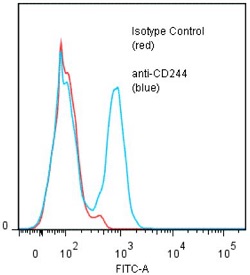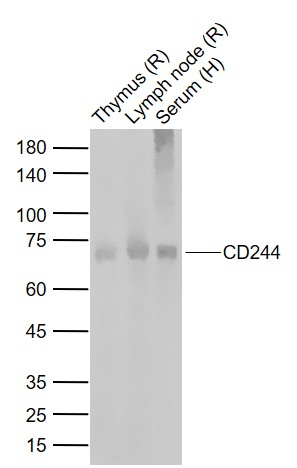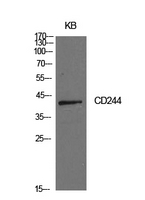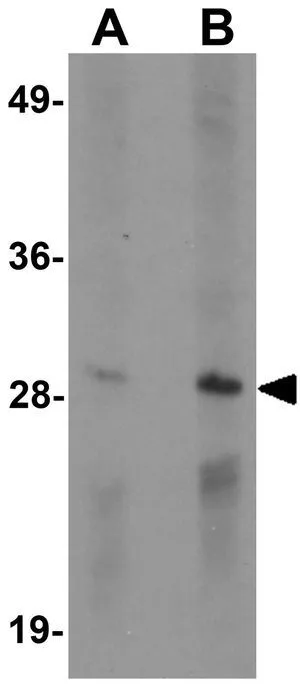
Binding of anti-CD244 (ANC244.8/8F7) +GAM/FITC to human PBL. Method: Five x 10^5 ficoll prepared human PBMC were washed and incubated 45 minutes on ice with 80ul of anti-CD244 (clone ANC244.8) antibody at 10ug/ml. Cells were washed twice and incubated with 2nd reagent Goat anti-Mouse IgG/FITC (#ANC-232-011), after which they were washed three times, fixed and analyzed by FACS using a lymphocyte gate. A net 43% sub population of cells stained positive with a mean shift of 0.83 log10 fluorescent units when compared to a Mouse IgG1 negative control (#ANC-278-010).
anti-CD244 [2B4] (human), mAb (ANC244.8/8F7) (preservative free)
ANC-239-820
ApplicationsFlow Cytometry, ELISA
Product group Antibodies
ReactivityHuman
TargetCD244
Overview
- SupplierAncell Corporation
- Product Nameanti-CD244 [2B4] (human), mAb (ANC244.8/8F7) (preservative free)
- Delivery Days Customer10
- ApplicationsFlow Cytometry, ELISA
- CertificationResearch Use Only
- ClonalityMonoclonal
- Clone IDANC244.8/8F7
- Concentration1 mg/ml
- Estimated Purity>95%
- Gene ID51744
- Target nameCD244
- Target descriptionCD244 molecule
- Target synonyms2B4, NAIL, NKR2B4, Nmrk, SLAMF4, natural killer cell receptor 2B4, CD244 molecule, natural killer cell receptor 2B4, NK cell activation inducing ligand NAIL, NK cell activation-inducing ligand, NK cell type I receptor protein 2B4, SLAM family member 4, h2B4, signaling lymphocytic activation molecule 4
- HostMouse
- IsotypeIgG1
- Protein IDQ9BZW8
- Protein NameNatural killer cell receptor 2B4
- Scientific DescriptionCD244 (2B4; SLAMF4) is a 66kDa member of the CD2/SLAM related receptor family (SRR). It is expressed on NK, T cell subsets, monocytes and eosinophils. It is expressed at high levels on leuikemia initiating cells, and plays a role in their proliferative potential. In mice there are two transcription variants, a long form and a short form of CD244 each of which have distinct signaling properties. In humans, only the long form is expressed. Decreased CD244 expression on monocytes of SLE patients correlated (negatively) with autoantibody titer. CD244 mediated function in immune response can vary greatly dependant on the context of its ligation. - Monoclonal Antibody. Antibody ANC244.8 binds to recombinant CD244-muIg (#ANC-544-020) in EIA, and to cell surface CD244 on human PBL in FACS. ANC244.8 binds to a CD244 epitope that is distinct from the binding sites of clone ANC2B4/3B12 (#ANC-259-020). It blocks binding of clone C1.7. Isotype: Mouse IgG1kappa. Immunogen: Recombinant soluble human CD244. Applications: ELISA, FACS. 50mM Sodium Phosphate pH 7.5, 100mM KCl, 150mM NaCl. CD244 (2B4; SLAMF4) is a 66kDa member of the CD2/SLAM related receptor family (SRR). It is expressed on NK, T cell subsets, monocytes and eosinophils. It is expressed at high levels on leuikemia initiating cells, and plays a role in their proliferative potential. In mice there are two transcription variants, a long form and a short form of CD244 each of which have distinct signaling properties. In humans, only the long form is expressed. Decreased CD244 expression on monocytes of SLE patients correlated (negatively) with autoantibody titer. CD244 mediated function in immune response can vary greatly dependant on the context of its ligation.
- ReactivityHuman
- Storage Instruction2°C to 8°C
- UNSPSC12352203




![anti-CD244 [2B4] (human), mAb (ANC244.8/8F7)](https://adipogen.com/pub/media/catalog/product/a/n/anc-259-020-facs-web250_1.png)

